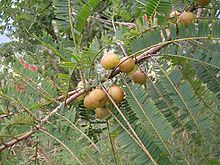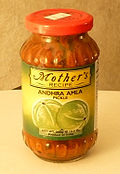- Phyllanthus emblica
-
Indian gooseberry (amla) 
Scientific classification Kingdom: Plantae (unranked): Angiosperms (unranked): Eudicots (unranked): Rosids Order: Malpighiales Family: Phyllanthaceae Tribe: Phyllantheae Subtribe: Flueggeinae Genus: Phyllanthus Species: P. emblica Binomial name Phyllanthus emblica
L.[1]Synonyms Cicca emblica Kurz
Emblica officinalis Gaertn.
Mirobalanus embilica Burm.
Phyllanthus mairei Lév.Phyllanthus emblica (syn. Emblica officinalis), the Indian gooseberry, or aamla, is a deciduous tree of the Phyllanthaceae family. It is known for its edible fruit of the same name.
Contents
Plant anatomy and harvesting
The tree is small to medium in size, reaching 8 to 18 m in height, with a crooked trunk and spreading branches. The branchlets are glabrous or finely pubescent, 10–20 cm long, usually deciduous; the leaves are simple, subsessile and closely set along branchlets, light green, resembling pinnate leaves. The flowers are greenish-yellow. The fruit are nearly spherical, light greenish yellow, quite smooth and hard on appearance, with six vertical stripes or furrows.
Ripening in autumn, the berries are harvested by hand after climbing to upper branches bearing the fruits. The taste of Indian gooseberry is sour, bitter and astringent, and it is quite fibrous. In India, it is common to eat gooseberries steeped in salt water and turmeric to make the sour fruits palatable[citation needed]. It is also used to straighten hair.
Medical research
Indian gooseberry has undergone preliminary research, demonstrating in vitro antiviral and antimicrobial properties.[2] There is preliminary evidence in vitro that its extracts induce apoptosis and modify gene expression in osteoclasts involved in rheumatoid arthritis and osteoporosis.[3] It may prove to have potential activity against some cancers.[4] One recent animal study found treatment with E. officinalis reduced severity of acute pancreatitis (induced by L-arginine in rats). It also promoted the spontaneous repair and regeneration process of the pancreas occurring after an acute attack.[5]
Experimental preparations of leaves, bark or fruit have shown potential efficacy against laboratory models of disease, such as for inflammation, cancer, age-related renal disease, and diabetes.[6][7][8]
A human pilot study demonstrated a reduction of blood cholesterol levels in both normal and hypercholesterolemic men with treatment.[9] Another recent study with alloxan-induced diabetic rats given an aqueous amla fruit extract has shown significant decrease of the blood glucose, as well as triglyceridemic levels and an improvement of the liver function caused by a normalization of the liver-specific enzyme alanine transaminase activity.[10]
Although these fruits are reputed to contain high amounts of ascorbic acid (vitamin C), 445 mg/100g,[11] the specific contents are disputed, and the overall antioxidant strength of amla may derive instead from its high density of tannins.[12] The fruit also contains other polyphenols: flavonoids, kaempferol, ellagic acid and gallic acid.[12][13]
Traditional uses
Medicinal use
In traditional Indian medicine, dried and fresh fruits of the plant are used. All parts of the plant are used in various Ayurvedic/Unani medicine (Jawarish amla) herbal preparations, including the fruit, seed, leaves, root, bark and flowers.[14] According to Ayurveda, aamla fruit is sour (amla) and astringent (kashaya) in taste (rasa), with sweet (madhura), bitter (tikta) and pungent (katu) secondary tastes (anurasas).[14] Its qualities (gunas) are light (laghu) and dry (ruksha), the postdigestive effect (vipaka) is sweet (madhura), and its energy (virya) is cooling (shita).[12]
According to Ayurveda, aamla balances all three doshas. While aamla is unusual in that it contains five out of the six tastes recognized by Ayurved, it is most important to recognize the effects of the "virya", or potency, and "vipaka", or post-digestive effect. Considered in this light, aamla is particularly helpful in reducing pitta due to its cooling energy.[14] and balances both Pitta and vata by virtue of its sweet taste. The kapha is balanced primarily due to its drying action. It may be used as a rasayana (rejuvenative) to promote longevity, and traditionally to enhance digestion (dipanapachana), treat constipation (anuloma), reduce fever (jvaraghna), purify the blood (raktaprasadana), reduce cough (kasahara), alleviate asthma (svasahara), strengthen the heart (hrdaya), benefit the eyes (chakshushya), stimulate hair growth (romasanjana), enliven the body (jivaniya), and enhance intellect (medhya).[14]
In Ayurvedic polyherbal formulations, Indian gooseberry is a common constituent, and most notably is the primary ingredient in an ancient herbal rasayana called Chyawanprash.[12] This formula, which contains 43 herbal ingredients as well as clarified butter, sesame oil, sugar cane juice, and honey, was first mentioned in the Charaka Samhita as a premier rejuvenative compound.[15][16]
In Chinese traditional therapy, this fruit is called yuganzi (余甘子), which is used to cure throat inflammation.
Emblica officinalis tea may ameliorate diabetic neuropathy. In rats it significantly reduced blood glucose, food intake, water intake and urine output in diabetic rats compared with the non‐ diabetic control group.[17]
Culinary use
Particularly in South India, the fruit is pickled with salt, oil, and spices. Aamla is eaten raw or cooked into various dishes. In Andhra Pradesh, tender varieties are used to prepare dal (a lentil preparation), and amle ka murabbah, a sweet dish indigenous to the northern part of India (wherein the berries are soaked in sugar syrup for a long time till they are imparted the sweet flavor); it is traditionally consumed after meals.
Other uses
Popularly used in inks, shampoos and hair oils, the high tannin content of Indian gooseberry fruit serves as a mordant for fixing dyes in fabrics.[14] Amla shampoos and hair oil are traditionally believed to nourish the hair and scalp and prevent premature grey hair.[citation needed]
Alternate names
Names of this tree in Indian and other languages include:
amalika (अम्लिका) in Sanskrit
aamla (आँवला) in Hindi
aamla (આમળા) in Gujarati
aavnlaa (awla) (or awla) in اردو
aavalaa (आवळा) (or awla) in Marathi
avaalo (आवाळो) in Konkani
sunhlu in Mizo
amala (अमला) in Nepali
amloki (আমলকী) in Bengali
amlakhi in Assamese
aanla in Oriya
olay in Punjabi
nellikka (നെല്ലിക്ക) in Malayalam
heikru in Manipuri
sohmylleng in Khasi
usiri (ఉసిరి కాయ) (or usirikai ) in Telugu
nellikkai (நெல்லிக்காய்/ ನೆಲ್ಲಿ ಕಾಯಿ/ ಗುಡ್ದದ ನೆಲ್ಲಿ)(or nellikkaai, nellikaayi) in Tamil and Kannada
nelli (නෙල්ලි) in Sinhala
mak kham bom in Lao
ma kham pom (มะขามป้อม) in Thai
anmole (庵摩勒) in Chinese
skyu ru ra (སྐྱུ་རུ་ར་) in Tibetan
melaka in Malay, A state in Malaysia, Malacca was named after this tree.
zee phyu thee (ဆီးၿဖဴသီး) in MyanmarAlso found are the names emblic, emblic myrobalan, malacca tree and the variants in spelling aola, ammalaki, aamvala, aawallaa, dharty, nillika, and nellikya.
See also
Emblicanin (antioxidant)
Gallery
References
- ^ "Phyllanthus emblica information from NPGS/GRIN". US Department of Agriculture. http://www.ars-grin.gov/cgi-bin/npgs/html/taxon.pl?28119. Retrieved 2008-03-06.
- ^ Saeed S, Tariq P (Jan 2007). "Antibacterial activities of Emblica officinalis and Coriandrum sativum against Gram negative urinary pathogens". Pak J Pharm Sci 20 (1): 32–5. PMID 17337425.
- ^ Penolazzi L et al. Induction of apoptosis of human primary osteoclasts treated with extracts from the medicinal plant Emblica officinalis. BMC Compl Altern Med 2008;8:59 [1]
- ^ Ngamkitidechakul C, Jaijoy K, Hansakul P, Soonthornchareonnon N, Sireeratawong S.,"Antitumour effects of Phyllanthus emblica L.: induction of cancer cell apoptosis and inhibition of in vivo tumour promotion and in vitro invasion of human cancer cells." Phytother Res. 2010 Sep;24(9):1405-13
- ^ Shabir Sidhu, Promila Pandhi, Samir Malhotra, Kim Vaiphei, Kundal Lal Khanduja ,"Beneficial Effects of Emblica officinalis in l-Arginine-Induced Acute Pancreatitis in Rats", Journal of Medicinal Food. January/February 2011, 14(1-2): 147-155.
- ^ Ganju L, Karan D, Chanda S, Srivastava KK, Sawhney RC, Selvamurthy W (Sep 2003). "Immunomodulatory effects of agents of plant origin". Biomed Pharmacother. 57 (7): 296–300. doi:10.1016/S0753-3322(03)00095-7. PMID 14499177. http://linkinghub.elsevier.com/retrieve/pii/S0753332203000957.
- ^ Yokozawa T, Kim HY, Kim HJ, et al. (Sep 2007). "Amla (Emblica officinalis Gaertn.) attenuates age-related renal dysfunction by oxidative stress". J Agric Food Chem. 55 (19): 7744–52. doi:10.1021/jf072105s. PMID 17715896.
- ^ Rao TP, Sakaguchi N, Juneja LR, Wada E, Yokozawa T (2005). "Amla (Emblica officinalis Gaertn.) extracts reduce oxidative stress in streptozotocin-induced diabetic rats". J Med Food 8 (3): 362–8. doi:10.1089/jmf.2005.8.362. PMID 16176148.
- ^ Jacob A, Pandey M, Kapoor S, Saroja R (Nov 1988). "Effect of the Indian gooseberry (amla) on serum cholesterol levels in men aged 35-55 years". Eur J Clin Nutr 42 (11): 939–44. PMID 3250870.
- ^ Qureshi SA, Asad W, Sultana V (Jan 2009). "The Effect of Phyllantus emblica Linn on Type — II Diabetes, Triglycerides and Liver — Specific Enzyme". Pakistan Journal of Nutrition. 8 (2): 125–128. doi:10.3923/pjn.2009.125.128. http://www.pjbs.org/pjnonline/fin991.pdf.
- ^ Tarwadi K, Agte V (Aug 2007). "Antioxidant and micronutrient potential of common fruits available in the Indian subcontinent". Int J Food Sci Nutr 58 (5): 341–9. doi:10.1080/09637480701243905. PMID 17558726.
- ^ a b c d Dharmananda S. Emblic Myrobalans: Amla, Institute of Traditional Medicine [2]
- ^ Habib-ur-Rehman, Yasin KA, Choudhary MA, et al. (Jul 2007). "Studies on the chemical constituents of Phyllanthus emblica". Nat. Prod. Res. 21 (9): 775–81. doi:10.1080/14786410601124664. PMID 17763100.
- ^ a b c d e Caldecott T. Amalaki
- ^ Samhita C. Ed., translation by the Shree Gulabkunverba Society, Volume 4. Chikitsa Sthana, Jamnagar, India: 1949
- ^ Indian Ministry of Health and Family Planning. The Ayurvedic Formulary of India. Part I. 1st ed. Delhi, 1978.
- ^ Vinod Tiwari, Anurag Kuhad and Kanwaljit Chopra,"Emblica officinalis Corrects Functional,Biochemical and Molecular Deficits in Experimental Diabetic Neuropathy by Targeting the Oxido-nitrosative Stress Mediated Inflammatory Cascade" PHYTOTHERAPY RESEARCH Phytother. Res. (2011) Published online in Wiley Online Library (wileyonlinelibrary.com) DOI: 10.1002/ptr.344 http://onlinelibrary.wiley.com/doi/10.1002/ptr.3440/pdf
Further reading
- Winston, David; Maimes, Steven (2007). Adaptogens: Herbs for Strength, Stamina, and Stress Relief. Healing Arts Press. ISBN 1594771588. Contains a detailed monograph on Emblica officinalis (Amla; Indian gooseberry; Amalaki) as well as a discussion of health benefits.
- Puri, Harsharnjit Singh (2002). "Amalaki (Phyllanthus emblica)". Rasayana: Ayurvedic Herbs for Longevity and Rejuvenation. Traditional Herbal Medicines for Modern Times, Vol. 2. Boca Raton: CRC. pp. 22–42. ISBN 0-415-28489-9.
- Caldecott, Todd (2006). Ayurveda: The Divine Science of Life. Elsevier/Mosby. ISBN 0723434107. Contains a detailed monograph on Phyllanthus emblica (Amla; Indian gooseberry; Amalaki) as well as a discussion of health benefits and usage in clinical practice. Available online at http://www.toddcaldecott.com/index.php/herbs/learning-herbs/397-amalaki
Human hair color Hair color Hair coloring Blue rinse · Grecian Formula · Hair dye stripping · Hair highlighting · Henna · Hydrogen peroxide · Indian gooseberry · Juglans nigra · Senna · Blue hairOther Categories:- Phyllanthus
- Berries
- Flora of India
- Flora of Pakistan
- Ayurvedic medicaments
Wikimedia Foundation. 2010.





